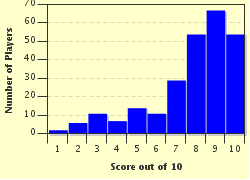Quiz Answer Key and Fun Facts
1. Acid rain has adversely affected buildings, metals structures and ecosystems, sometimes with devastating outcomes. SOx and NOx (read as 'socks and knocks'!) are gases generated by a range of industrial processes and car exhausts. How do these gases then turn into acid rain? Hint: What is the dominant component of rain?
2. Electrolysis of water involves passing an electrical current though the water and is often used to generate gases for industrial use. Which two gases are produced in this process?
3. In an internal combustion engine such as those found in most cars, gasoline (petrol) in the cylinder is ignited by a spark plug. How does this process provide the power to drive the pistons and hence the engine?
4. Batteries are found in a wide variety of applications around the home - from large lead-acid car batteries to those AA or AAA batteries in remote controls and video games. Batteries generate electrical current through which two concurrent processes which are often abbreviated as 'redox'?
5. This chemical reaction costs the global economy billions of dollars each year. It affects and eventually weakens metal structures and the most obvious external sign is brown discoloration. Yes, this is rust, which occurs when certain surfaces are exposed to the air and occurs much more rapidly if the surface is wet. Which two chemical elements make up rust?
6. Antacids are used to treat gastric (gastroesophageal) reflux also called heartburn - that horrible burning sensation caused by stomach acid moving up into the esophagus. Antacids are one common treatment and are typically relatively simple bases, like baking soda, that react with the acid to form a salt and water. What is the name for this type of chemical reaction?
7. Developed early in the twentieth century, the Haber-Bosch process has allowed the industrial production of a particular fertilizer in extremely large quantities. It is estimated that one-third of the world's population is directly supported by food grown using this fertilizer. What is the name of this chemical, which can have quite a sharp smell?
8. Baking soda (sodium bicarbonate) creates carbon dioxide gas by reacting with acidic components in the food mixture. Why would this be desirable in cooking?
9. Catalysts are often used in chemical reactions. These can include chemical compounds used in industrial reactions, such as titanium or chromium compounds used in the formation of polyethylene from ethylene gas, or enzymes in many biochemical processes. What is the common purpose of these catalysts?
10. Photosynthesis is a (bio)chemical process occurring in plants. The plants use sunlight as an energy source to turn carbon dioxide, water and some other nutrients into new plant material and a vital gas for all air breathing organisms (including us!). What is this gas?
Source: Author
MikeMaster99
This quiz was reviewed by FunTrivia editor
WesleyCrusher before going online.
Any errors found in FunTrivia content are routinely corrected through our feedback system.

